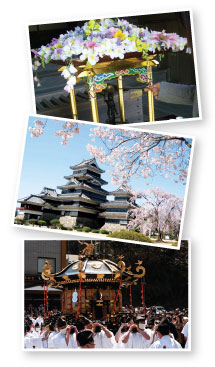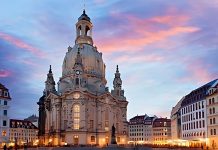If you’ve had enough of being the tourist on your holiday, you’re going to love these travel ideas. With the oncoming Spring, April sees a bunch of interesting festivals where there’s no other way but to be part of the crowd.
Hana Matsuri, Japan
 The low-down: On April 8, Japan celebrates Buddha’s birthday in the form of Hana Matsuri, the flower festival. An interesting ceremony called Kanbutsu-e, or the bathing of Buddha, takes place in the temples here. With its origins in China, this practice was first brought to Japan in the year 606, in Nara. On an altar decorated with flowers to symbolise the Lumbini garden, a small statue of their lord is placed in a shallow metal bowl.
The low-down: On April 8, Japan celebrates Buddha’s birthday in the form of Hana Matsuri, the flower festival. An interesting ceremony called Kanbutsu-e, or the bathing of Buddha, takes place in the temples here. With its origins in China, this practice was first brought to Japan in the year 606, in Nara. On an altar decorated with flowers to symbolise the Lumbini garden, a small statue of their lord is placed in a shallow metal bowl.
X-factor: The day is celebrated with parades featuring images of the baby Buddha, the white elephant seen by his mother in her dream just before his birth, and cherry blossoms carried by children dressed in traditional Japanese clothes. This is probably because the sakura trees that are popular in the country blossom around the same time as the festival.
In addition to these offerings “amacha”, sweet tea symbolic of the heavenly rain, is poured over the baby Buddha statue by children.
Best for: Those who appreciate diverse traditional rituals. Tokyo is especially festive at this time. Head for the Sensoji Temple in the ancient Asakusa district of the city where there is an exquisite children’s parade in the morning.
Songkran, Thailand
 The low-down: You’ve probably already been here to unwind on one of their beautiful beaches. For those who haven’t yet visited Thailand, this month is the best time to get out there and have some real fun. Songkran is a three-day celebration of Thailand’s traditional New Year, starting on April 13. “Mahasongkran” marks the end of the old year.
The low-down: You’ve probably already been here to unwind on one of their beautiful beaches. For those who haven’t yet visited Thailand, this month is the best time to get out there and have some real fun. Songkran is a three-day celebration of Thailand’s traditional New Year, starting on April 13. “Mahasongkran” marks the end of the old year.
“Wan Nao,” on April 14, is the day after, and April 15 is “Wan Thaloeng Sok”, when the New Year begins.
It marks the beginning of the solar year and is probably the biggest party of the nation. But this is no ordinary carnival. If you took part in the Indian festival, Holi, in March, you are prepared to face the madness they have in store this month.
X-factor: Though it is celebrated all over Thailand with great gusto and enthusiasm, it is in Chiang Mai that the very important ritual of bathing the Buddha is held and people from all over come to be witness to this event.
On New Year’s Day, Thais pray to the Buddha, clean temples and houses, offer alms to the monks and sprinkle scented water on elders as a mark of respect. The pouring of water is symbolic of the cleansing of the spirit, mind and body. The water is also supposed to wash away bad luck — so consider yourself blessed if you get drenched because that is exactly what is going to happen. Happily, Songkran falls during the hottest time of the year and the water is a welcome relief.
Best for: Those who enjoy paintball wars. Dare to step out and you’d be soaked to the skin in seconds, for it’s a given that you won’t escape the water pistols, the water balloons and buckets of water.
Baisakhi, India
 The low-down: Loud music, bright colours and a lot of food are a given at any Indian bash. Now put the Punjabi New Year and their harvest festival together, and you’ve got the carnival of a lifetime right there. For the Sikhs, Baisakhi holds even greater significance as it commemorates the day when the tenth Sikh guru, Guru Gobind Singh, founded the Khalsa Panth which marks the founding of their community.
The low-down: Loud music, bright colours and a lot of food are a given at any Indian bash. Now put the Punjabi New Year and their harvest festival together, and you’ve got the carnival of a lifetime right there. For the Sikhs, Baisakhi holds even greater significance as it commemorates the day when the tenth Sikh guru, Guru Gobind Singh, founded the Khalsa Panth which marks the founding of their community.
X-factor: In Punjab, Baisakhi is celebrated with the utmost fervour and exuberance. On this auspicious day, traditionally, the Sikhs pay a visit to the temple where they pay their respects and volunteers serve a meal to the people. Taking part in this feast is considered a blessing. There probably isn’t a place more tranquil than the Golden Temple, which makes it a must-visit especially during these days.
A religious procession ensues, in which five religious heads walk in front of their holy book holding out a sword. Devotional music is played during the procession, and hymns are sung, both along the way and at the temples. Dressed in their distinct folk attire, both men and women express their joy by dancing the bhangra and gidda.
Best for: Those in the mood for absolute fun. This isn’t something you enjoy from a distance. Get out there, into the fields and join them as they shake a leg to the beat of the dhol, a double-headed drum.




































